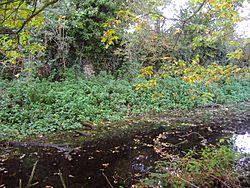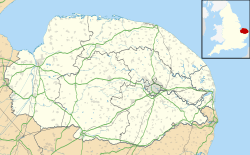Gresham Castle facts for kids
Quick facts for kids Gresham Castle |
|
|---|---|
| North Norfolk, East of England, Norfolk | |

The overgrown curtain walls of Gresham Castle
|
|
|
Gresham castle within Norfolk
|
|
| Coordinates | 52°53′47″N 1°13′11″E / 52.8964°N 1.2197°E |
| Type | Castle |
| Site history | |
| Built | Fortified in 1318 |
Gresham Castle is found south of the village of Gresham in Norfolk, England. This medieval castle was actually a strong, fortified country house.
In 1318, Sir Edmund Bacon got permission to add defenses to his manor house. This meant he could build battlements, which are the notched walls often seen on castles. Gresham was one of the last castles to be built or strengthened along England's east coast. Other castles from this time include Baconsthorpe and Caister.
Contents
What Does Gresham Castle Look Like?
Gresham Castle is in a green field near the village. It has a rectangular shape with a round part sticking out at the northwest corner. A moat surrounds the castle site. This moat is about 12 to 15 feet wide in some places. It still holds water, which can make it hard to reach the castle remains.
The moat's water once came from Gur Beck. This stream has since been moved. It now flows about 50 meters away from the castle ruins. The central area of the castle is about 2,378 square meters. It has round towers that are 35 feet across.
The castle area is very overgrown with trees and bushes. This makes it difficult to see the whole castle at once. The tower at the southeast corner sticks out from the main platform. You can still see parts of the two corner towers on the west side. One of these towers is much bigger than the other. Between them, a piece of the main wall still stands about six feet tall.
The layout of the site suggests there were also towers on the east side. The tower at the northwest corner was as big as a keep. A keep is the strongest, most protected part of a castle. In 1846, when the moat was cleaned, large timbers were found. These were thought to be parts of a drawbridge, an entrance, and even a boat.
The Story of Gresham Castle
How William Paston Acquired the Castle
In 1427, a lawyer named William Paston bought Gresham Castle. He also bought the manor, which was the land and houses connected to it. Paston already owned many properties in Norfolk. He bought Gresham Castle from Thomas Chaucer and Sir William Moleyns. Each of them owned half of the property.
However, the sale was challenged by a nobleman from Wiltshire. This was Robert Hungerford, Lord Moleyns. When William Paston died, he left Gresham Castle to his son, John Paston. Lord Moleyns' claim to half the property was supported by John Paston’s rival, John Haydon. Haydon lived nearby at Baconsthorpe Castle.
The Fight for Gresham Castle
On February 17, 1448, Lord Moleyns and his men took action. They entered the fortified manor house. They began collecting rent from the people living on the manor's land. After this, John Paston asked the king for help. His appeals worked, and Paston got his property back on October 6.
But on January 28, Moleyns returned. He brought a force of about one thousand men. These men were from the local area and from Wiltshire. They took over the castle again. This time, they forced John Paston’s wife, Margaret, and her twelve servants out.
Moleyns left one of his officers, named Partridge, to guard the castle. Partridge was told to barricade the castle. This was to stop Paston from taking it back. In the famous Paston Letters, Margaret wrote to her husband John about the situation. She explained how Partridge and his group were afraid. They thought John would try to enter the castle again.
Margaret wrote that they had made many defenses inside the house. They had put bars across the doors. They had also made small openings in every part of the house. These openings were for shooting arrows and using early handguns.
The Castle's Final Days
One year later, John Paston finally got the castle and manor back. This time, there was no resistance. He found that the castle was in very bad shape. It was not fit for anyone to live in.
In 1466, John Paston died. He left his estate, including Gresham Castle, to his oldest son, also named John. In 1471, Sir John Gresham thought about rebuilding Gresham Castle. He sent his brother, also named John, to look at the site. His brother was to draw up plans for rebuilding. However, no rebuilding ever happened. The castle site was left abandoned.
Images for kids



